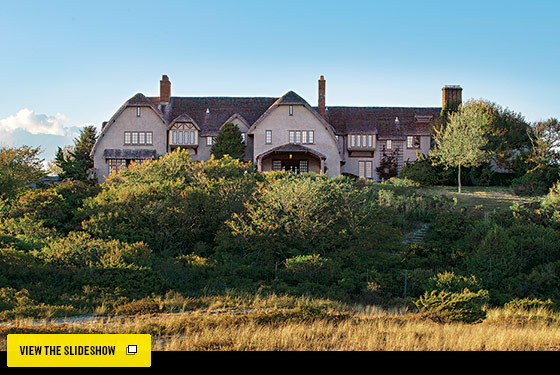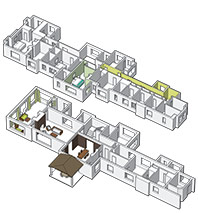
Photographs by Thomas Loof

From a distance, it was love at first sight—a long, narrow, mock-Elizabethan manor house built in the Cotswold style, sprawled across a bluff above the dunes bordering the greens of the Maidstone golf course in East Hampton. As my sister Gretchen recalls, “We felt like we were on the moors of Scotland.” Gretchen and her husband Jim Johnson’s 30-year romance with the house began when a real-estate agent showed them a place that “needs work.” The Johnsons didn’t know the current, seemingly absentee owner, nor any of the racy gossip that circulated about the Appletons, who had built the house in 1917–18. But they liked its name, Nid de Papillon (Butterfly’s Nest), and were intrigued when they glimpsed its thatched roof.
As they got closer, though, and began to explore the deserted house and grounds on that hot, cloudless August afternoon in 1982, a more complicated set of emotions came into play. The lawns were brown, and vintage milk bottles littered their edges, where feral shrubbery gave way to the dunes. Most mind-boggling of all, the elegant, 60-foot-long brick-walled sunken garden—which adjoined the house and boasted a Celtic baptismal font and hidden ovens built into the brickwork so the Appletons’ roses could bloom right into November—was now so densely overgrown with saplings and thorns that they literally could not step inside. But what would have sent most prospective buyers running simply made my sister think of a favorite book from childhood, The Secret Garden.
An eerie sense of enchantment and abandonment continued to grow when they entered and were greeted by a knight’s dusty suit of armor. Leaded panes of glass dangled from a towering stained-glass window that featured a family crest with a mauve elephant and the irresistible Latin motto Ex Malo Bonum (Out of Bad Comes Good). The Johnsons also remember that only one of the eight bathrooms worked and that there was a one-quarter-life-size plaster statue of a spritelike naked woman set into a recess that was rumored to be an exact likeness of a young Mrs. Appleton.
Venturing up the grand staircase to the bedrooms, they wondered aloud, “What happened to this house?” Closets contained bolts of fabric for curtains that were never made, and the drawers of a ladies’ dressing room were still neatly labeled GARTER BELTS, BRASSIERES, SILK STOCKINGS. In one of the bedrooms, the swollen wooden frame of a Gothic casement window that overlooked the Atlantic rattled spookily in the wind, in spite of the fact that someone had tried to tie it shut with a bikini top.
Proceeding to the attic, they looked up and saw blue sky, and when they looked down, leaks that ran through the second floor. They also realized that the roof (which should have been replaced several decades ago) was not in fact thatched but made of long, narrow wooden shingles steamed and bent by hand to look like thatch.
Back downstairs, they discovered a secret staircase, released by a hidden latch in the paneling, that led to what is referred to in architect Frank Eaton Newman’s plans as an English pub, which was perhaps the Appletons’ answer to Prohibition—a private speakeasy equipped with five Ye Olde booths, a small bar, a powder room, and a massive fireplace. Though the charm here, as in so many places in Nid de Papillon, was hard to see—no working lights and a slate floor littered with empty jeroboams of Champagne.
“The house felt abandoned, and the pathos of that captured me, called out to me. I had to have it,” my sister recalls.
Her husband, Jim, being a painter, appreciated the beauty of the place, but also possessing a strong strand of New England practicality in his DNA, he had a decidedly different initial reaction. “No way, never in a million years … it’d be a nightmare.” It took Gretchen all of 24 hours to convince her husband it could be their dream house. And after more than a few contracting nightmares, that is what it became.
Steel beams had to be installed under the side of the house that faced the ocean. New plumbing, new wiring, new stucco on the outside, new plaster inside, a whole family of Mennonite craftsmen induced to brave the temptations of the Hamptons for six months to replace the roof. Gretchen and Jim saved the house, some might say, in more ways than one. When they stumbled on it, they say, Donald Trump was interested in the property. Would he have torn it down? Who knows? But serendipity, magic, and the romance of a dream have played a part in the history of Nid de Papillon from its inception. According to local legend, 65 years before the Johnsons first took in the ocean views, Robert Appleton, a wealthy and newly divorced publisher, and his young wife, Katherine, chanced upon that spot on a summer picnic. Whether Katherine was his former secretary or an ex-showgirl remains open to debate; that she supposedly had a tattoo of a butterfly on one of her breasts makes me think she was the latter. Her tattoo, and the profusion of Monarch butterflies getting ready to set off on their impossible flight to Mexico, was too much kismet for the Appletons to resist, and they decided then and there to build Nid de Papillon and fill its bedrooms with children.
Sadly, their plans never came to pass. But Gretchen and Jim did have children, two sons and four daughters; by the summer of ’83, the house was filled with family. The Johnsons’ six children are grown now, and their extended clan has expanded to include thirteen grandchildren, three step-grandchildren, and nine nieces and nephews.
Nid de Papillon has become their tribe’s summer clubhouse, a stage set for family fun: birthdays, picnics, children’s plays, beach-plum picking, and hurriedly organized surf-casting expeditions when the striped bass are running.
What would the Appletons think of what the Johnsons have done with their dream house? Their spirits certainly seem to be having too much fun to leave. For one of the many wonders of Nid de Papillon is that it’s haunted. Gretchen swears, though she never fails to lock and bolt the house at the end of the evening, she often wakes up in the middle of the night to find the front door open wide and welcoming to the mist that swirls in off the ocean. Gretchen and Jim, being the gracious hosts they are, are happy to share the house with fellow free spirits, as long as they abide by the house rules: only one beach towel per day, and no smoking in the bedrooms.

The House on the Dunes
Built in 1917, Nid de Papillion is one of the last Hamptons homes that look almost exactly as they did when this beach was far less crowded. Its “thatched roof” is actually shingles.
Photo: Thomas Loof

The Ground Floor
Up the stairs, almost every bedroom faces the ocean;
there are so many that they’re numbered for guests’ convenience.
Photo: Thomas Loof

The Portico
One of the only additions to the
house by the Johnson family.
Photo: Thomas Loof

The Top-Floor Hallway
Originally for the servants’ quarters. Now there are more guest bedrooms.
Photo: Thomas Loof

The Cellar
Built as an English pub by the first owners, it would have made a cozy speakeasy during Prohibition.
Photo: Thomas Loof

The Sun Room
Facing the Atlantic, with all its original detailing intact.
Photo: Thomas Loof
